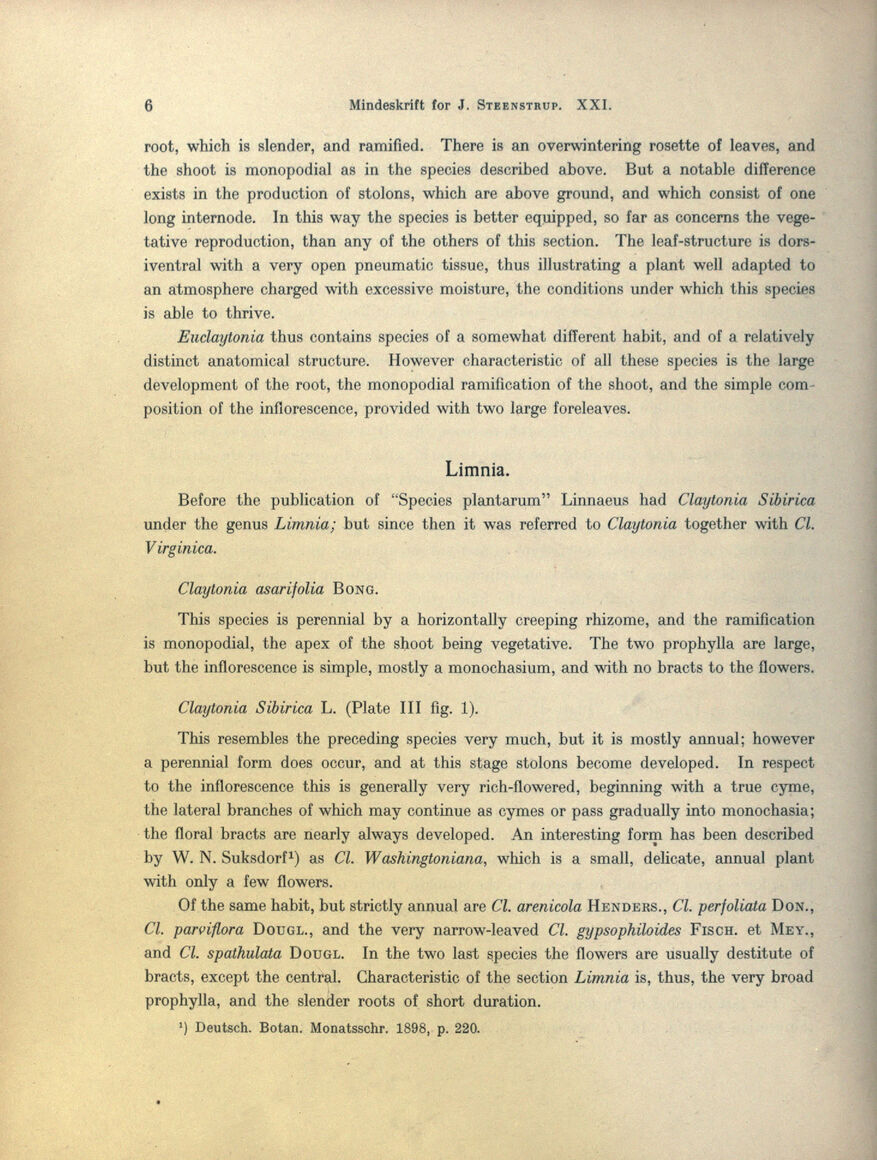
Full resolution (JPEG)
- On this page / på denna sida
- Euclaytonia
- Limnia

<< prev. page << föreg. sida << >> nästa sida >> next page >>
Below is the raw OCR text
from the above scanned image.
Do you see an error? Proofread the page now!
Här nedan syns maskintolkade texten från faksimilbilden ovan.
Ser du något fel? Korrekturläs sidan nu!
This page has been proofread at least once.
(diff)
(history)
Denna sida har korrekturlästs minst en gång.
(skillnad)
(historik)
root, which is slender, and ramified. There is an overwintering rosette of leaves, and
the shoot is monopodial as in the species described above. But a notable difference
exists in the production of stolons, which are above ground, and which consist of one
long internode. In this way the species is better equipped, so far as concerns the
vegetative reproduction, than any of the others of this section. The leaf-structure is
dorsiventral with a very open pneumatic tissue, thus illustrating a plant well adapted to
an atmosphere charged with excessive moisture, the conditions under which this specias
is able to thrive.
Euclaytonia thus contains species of a somewhat different habit, and of a relatively
distinct anatomical structure. However characteristic of all these species is the large
development of the root, the monopodial ramification of the shoot, and the simple
composition of the inflorescence, provided with two large foreleaves.
Limnia.
Before the publication of "Species plantarum" Linnaeus had Claytonia Sibirica
under the genus Limnia; but since then it was referred to Claytonia together with Cl.
Virginica.
Claytonia asarifolia Bong.
This species is perennial by a horizontally creeping rhizome, and the ramification
is monopodial, the apex of the shoot being vegetative. The two prophylla are large,
but the inflorescence is simple, mostly a monochasium, and with no bracts to the flowers.
Claytonia Sibirica L. (Plate III fig. 1).
This resembles the preceding species very much, but it is mostly annual; however
a perennial form does occur, and at this stage stolons become developed. In respect
to the inflorescence this is generally very rich-flowered, beginning with a true cyme,
the lateral branches of which may continue as cymes or pass gradually into monochasia;
the floral bracts are nearly always developed. An interesting form has been described
by W. N. Suksdorf[1] as Cl. Washingtoniana, which is a small, delicate, annual plant
with only a few flowers.
Of the same habit, but strictly annual are Cl. arenicola Henders., Cl. perfoliata Don.,
Cl. parviflora Dougl., and the very narrow-leaved Cl. gypsophiloides Fisch. et Mey.,
and Cl. spathulata Dougl. In the two last species the flowers are usually destitute of
bracts, except the central. Characteristic of the section Limnia is, thus, the very broad
prophylla, and the slender roots of short duration.
[1] Deutsch. Botan. Monatsschr. 1898, p. 220.
<< prev. page << föreg. sida << >> nästa sida >> next page >>
Project Runeberg, Sun Dec 10 11:30:00 2023
(aronsson)
(diff)
(history)
(download)
<< Previous
Next >>
https://runeberg.org/japetus100/xxi/0006.html



